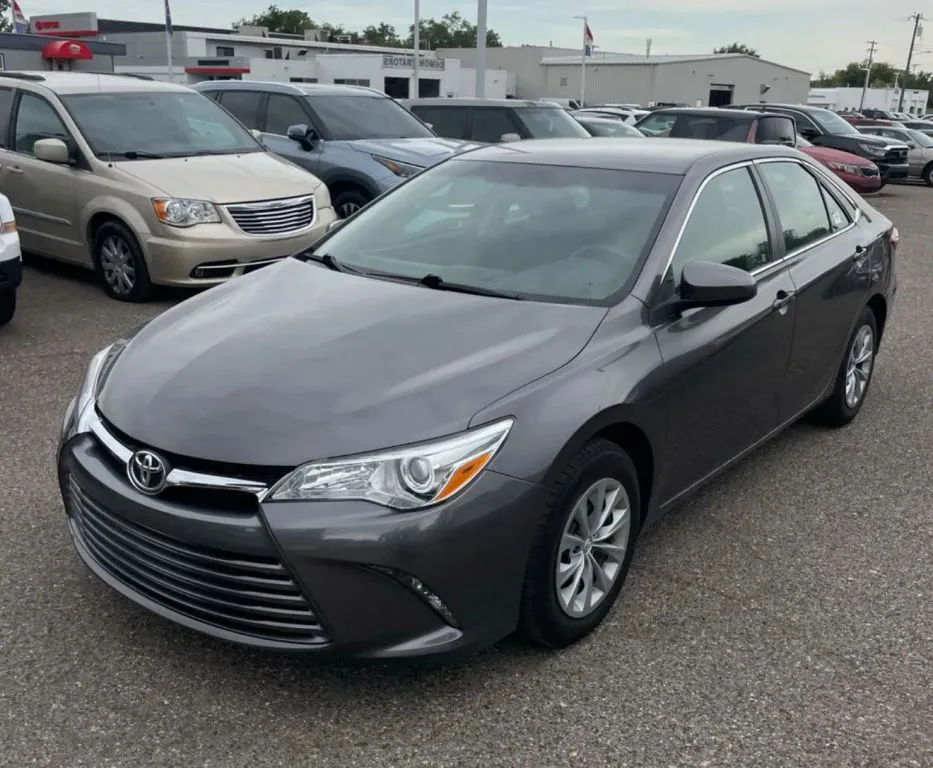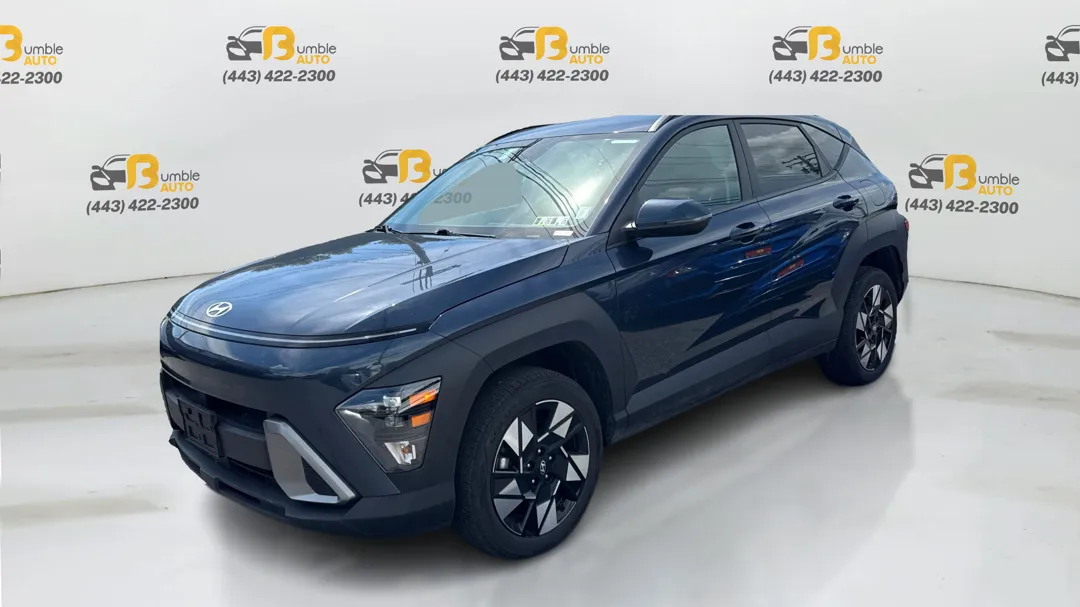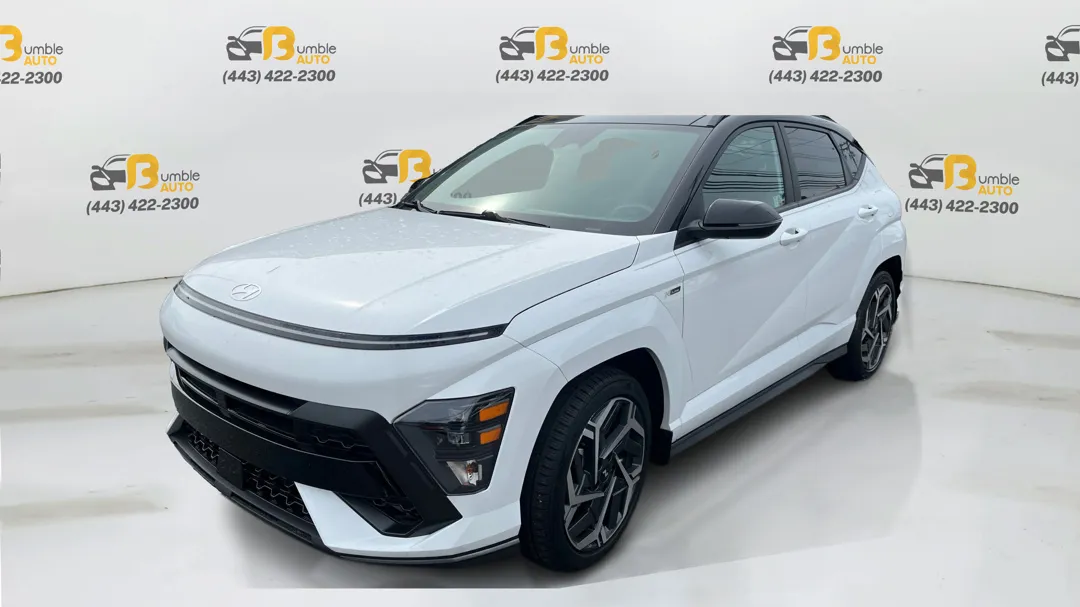How to Buy a Used Car: Tips, Tricks, and Must-Know Secrets for Smart Shoppers
Table of Contents
- Understanding the Used Car Market
- Setting Your Budget: What You Need to Consider
- Researching Your Options: Where to Find Used Cars
- Key Features to Look for in a Used Car
- Consider Your Lifestyle and Needs
- Focus on Safety Features
- Evaluate Reliability and Maintenance Costs
- The Importance of Vehicle History Reports
- Test Driving: What to Pay Attention To
- Negotiating the Best Price: Tips and Strategies
- 1. Start with Thorough Research
- 2. Make a Confident and Informed Offer
- 3. Don’t Overlook Additional Costs
- 4. Use Inspection Results to Your Advantage
- Finalizing the Purchase: Paperwork and Financing Options
- Review All Paperwork Carefully
- Shop for the Best Financing Terms
- Complete the Ownership Transfer and Registration
- Post-Purchase Tips: Maintenance and Care for Your Used Car

Buying a used car can feel like navigating a maze, filled with both exciting possibilities and daunting pitfalls. Whether you're a first-time buyer or a seasoned pro, the process demands careful consideration and informed decisions. Understanding the benefits of buying a used car is key to making informed decisions and maximizing your investment. With prices rising and inventory fluctuating, knowing how to buy a used car becomes crucial for savvy shoppers seeking value without compromise. In this comprehensive guide, we’ll unlock valuable tips, tricks, and insider secrets that empower you to make educated choices. From understanding vehicle history to negotiating like a pro, we’ll equip you with essential knowledge that turns the often-overwhelming car shopping experience into a rewarding adventure. Buckle up and get ready to drive off into your next journey with confidence and peace of mind!
Understanding the Used Car Market

Navigating the used car market can be a daunting task, but understanding its dynamics is the first step to making a smart purchase. The used car market is vast and varied, encompassing a wide range of vehicle types, conditions, and prices. Unlike new cars, used cars have histories that impact their value and reliability. Factors such as previous ownership, mileage, and maintenance records play crucial roles in determining a car's worth. By familiarizing yourself with these aspects, you can better assess the true value of any used car you consider.
The market is heavily influenced by supply and demand, which can fluctuate based on economic conditions, fuel prices, and even seasonal trends. For example, fuel-efficient cars often see increased demand when gas prices rise, while SUVs and trucks might become more popular during winter months. Understanding these trends can help you time your purchase to get the best deal. Additionally, consider the impact of new car sales on the used market. When new car sales decline, used car inventories tend to increase, often leading to better deals for buyers.
Another critical aspect of the used car market is the variety of sources from which you can buy. Dealerships, private sellers, and online platforms each offer different advantages and potential pitfalls. Dealerships may provide certified pre-owned vehicles with warranties, while private sellers might offer lower prices but less assurance of the car's condition. If you're considering online options, here's how to avoid scams in online purchasing and protect yourself from fraud. Online platforms have revolutionized the buying process, offering extensive inventories and the convenience of shopping from home. Each source requires a unique approach and due diligence to ensure you make a wise purchase.
Setting Your Budget: What You Need to Consider

Setting a budget is a fundamental step in the car-buying process, and it requires careful consideration of your financial situation and driving needs. Start by assessing your overall financial health, including your income, expenses, and any outstanding debts. This will give you a clear picture of how much you can comfortably spend on a car without straining your finances. Remember to factor in not just the purchase price, but also ongoing costs such as insurance, maintenance, fuel, and registration fees.
When determining your budget, it's also important to consider the total cost of ownership. While a cheaper car might seem like a good deal upfront, it could end up costing more in the long run due to higher maintenance and repair costs. Consider the do's and don'ts of buying a used car to avoid budget pitfalls and hidden costs. Research the reliability and average maintenance costs of the models you're interested in. Additionally, consider the car's fuel efficiency, as gas prices can significantly impact your monthly expenses. It's wise to allocate a portion of your budget for unexpected repairs and emergencies to avoid financial stress down the road.
Financing options are another key factor in setting your budget. If you're taking out a loan, shop around for the best interest rates and terms. A lower interest rate can save you a significant amount of money over the life of the loan. Be mindful of how much you're borrowing relative to the car's value, as being "upside-down" on a loan—owing more than the car is worth—can be risky. It's generally recommended to make a down payment of at least 20% to reduce the amount you need to finance and to lower your monthly payments. By carefully considering these factors, you'll set a realistic budget that aligns with your financial goals and needs.
Researching Your Options: Where to Find Used Cars
Finding the right used car requires thorough research and exploration of various sources. One of the most traditional and reliable places to start is at a dealership. Dealerships often offer a wide selection of used cars, including certified pre-owned (CPO) vehicles that have undergone rigorous inspections and come with extended warranties. While prices at dealerships may be higher than those from private sellers, the added assurance and customer service can be worth the extra cost. Additionally, many dealerships provide financing options, making the purchase process more convenient.
Another popular option is to buy from a private seller. Websites like Craigslist, Facebook Marketplace, and local classifieds are excellent places to find private sellers offering used cars. Buying from a private seller can often lead to lower prices as there are no dealership markups. However, this approach requires more diligence on your part. It's crucial to thoroughly inspect the car, verify its history, and ensure all paperwork is in order. Private sales typically do not offer warranties, so it's important to have the car checked by a trusted mechanic before finalizing the deal.
Online car-buying platforms have revolutionized the way people shop for used cars. Websites like Autotrader, Cars.com, and Carvana offer extensive inventories and detailed listings that include photos, vehicle history reports, and user reviews. These platforms provide the convenience of browsing a wide range of vehicles from the comfort of your home. Some even offer home delivery and return policies, giving you a risk-free way to test the car. Online platforms also allow you to compare prices across different sellers, helping you find the best deal. Regardless of where you choose to buy, thorough research and careful consideration of your options are key to finding the perfect used car. This includes evaluating used car dealers based on reputation, transparency, inventory, and after-sale services.
Key Features to Look for in a Used Car
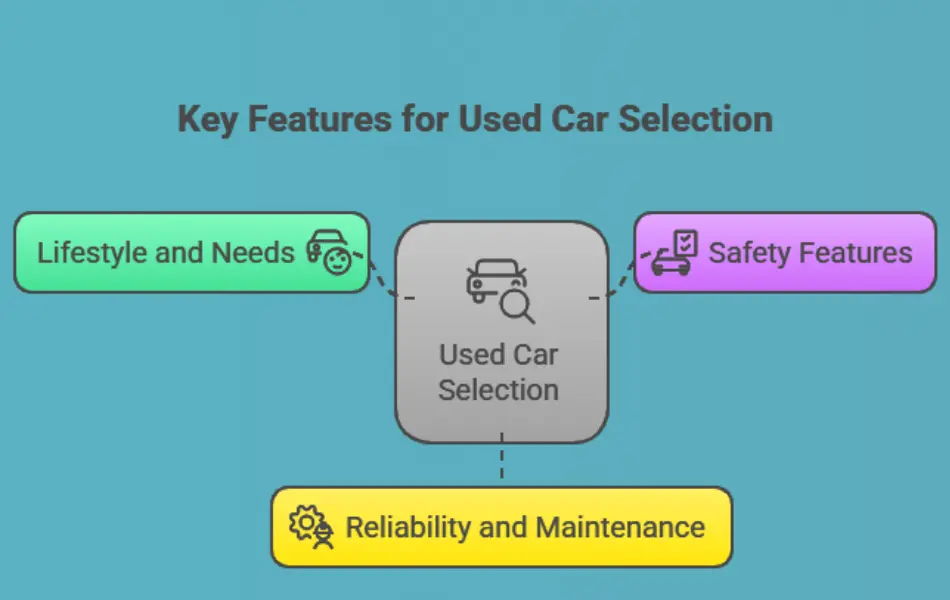
Finding the right used car involves more than just picking a make and model. Paying attention to key features can help ensure your purchase is practical, safe, and long-lasting.
Consider Your Lifestyle and Needs
Start by thinking about how you plan to use the vehicle. If you have a long daily commute, prioritize fuel efficiency, comfort, and a smooth ride. Families may need more seating, advanced safety features, and generous cargo space. Create a list of your “must-haves” to help you quickly eliminate vehicles that don’t meet your criteria.
Focus on Safety Features
Safety should always be at the top of your checklist. Look for essential features such as:
- Anti-lock Brakes (ABS)
- Electronic Stability Control (ESC)
- Multiple airbags
Advanced safety technologies like blind-spot monitoring, rearview cameras, and automatic emergency braking add an extra layer of protection. To be confident in a car’s crashworthiness, check safety ratings from the National Highway Traffic Safety Administration (NHTSA) and the Insurance Institute for Highway Safety (IIHS).
Evaluate Reliability and Maintenance Costs
Reliability plays a huge role in long-term satisfaction. Some vehicles are known for their durability and low cost of ownership. Use platforms like Consumer Reports and J.D. Power to review reliability ratings.
Also, consider:
- Frequency of known mechanical issues
- The average cost of repair
- Availability of replacement parts
A reliable used car with affordable maintenance will save you time, money, and headaches down the road. Always prioritize checking for engine health as part of your inspection checklist.
The Importance of Vehicle History Reports

A vehicle history report is an essential tool when buying a used car, providing critical information about the car's past that can help you make an informed decision. These reports, available from companies like Carfax and AutoCheck, include details about previous ownership, accident history, title status, odometer readings, and service records. By reviewing a vehicle history report, you can uncover potential red flags that may not be immediately apparent during a physical inspection or test drive.
One of the most important aspects of a vehicle history report is its accident history. Cars that have been involved in significant accidents may have underlying damage that can affect their safety and performance. Even if repairs were made, the quality of those repairs can vary. Understanding the extent and nature of any past accidents helps you assess the car's current condition and potential future issues. Additionally, a car with a clean accident history typically retains its value better and may have lower insurance premiums.
Odometer fraud, where the mileage on the car is tampered with to appear lower, is another concern that vehicle history reports can address. Accurate odometer readings are crucial in assessing a car's wear and tear. A vehicle history report can reveal inconsistencies in mileage records, helping you avoid cars with potentially fraudulent odometer readings. Furthermore, these reports provide insights into the car's service and maintenance history. Regular maintenance is a good indicator of how well the car has been cared for. A well-documented service history suggests that the previous owner took good care of the vehicle, which can translate to fewer problems down the road. By thoroughly reviewing a vehicle history report, you can avoid many common pitfalls and make a more confident purchase.
Test Driving: What to Pay Attention To

A test drive is one of the most critical steps in the car-buying process, allowing you to experience how the car performs and identify any potential issues. Start by checking the ease of entering and exiting the vehicle and the comfort of the seating position. Adjust the mirrors and seat to ensure good visibility and a comfortable driving posture. Pay attention to the ergonomics of the controls and how intuitive they are to use.
During the test drive, focus on the car's performance in various driving conditions. Test the acceleration and responsiveness of the engine, as well as the smoothness of the transmission shifts. Listen for any unusual noises, such as knocking, rattling, or squealing, which could indicate mechanical issues. Evaluate the car's handling and stability by taking it on different types of roads, including highways, city streets, and winding roads. Pay attention to the steering response and the car's ability to maintain a straight line without excessive corrections.
Braking performance is another crucial aspect to assess during the test drive. Test the brakes in different scenarios, including gentle stops and sudden braking. The brakes should feel firm and responsive, without any vibrations or pulling to one side. Additionally, test the car's suspension by driving over bumps and uneven surfaces. The suspension should absorb shocks smoothly without excessive bouncing or noise. By thoroughly evaluating these aspects during the test drive, you can gain a comprehensive understanding of the car's condition and performance, helping you make an informed decision.
Negotiating the Best Price: Tips and Strategies

Buying a used car doesn’t mean you have to accept the sticker price. With preparation and the right approach, you can negotiate effectively and secure a deal that truly fits your budget.
1. Start with Thorough Research
Knowledge is your strongest asset when entering negotiations. Alongside research, these tips for a successful used car buying experience will prepare you for every phase of the process. Use trusted online resources like Kelley Blue Book and Edmunds to determine the fair market value of the car based on its make, model, year, mileage, and condition. This research gives you a clear idea of what the car is really worth, helps you spot inflated prices, and builds your confidence going into the negotiation.
2. Make a Confident and Informed Offer
Approach the negotiation calmly and confidently. Start with an initial offer that’s lower than the asking price but still within a reasonable range based on your research. This strategy shows the seller you’re serious but leaves room for flexibility. Be prepared to justify your offer with data and facts. If the seller counters, take time to consider their price carefully, and don’t hesitate to respond with a counteroffer of your own.
3. Don’t Overlook Additional Costs
Always look beyond just the vehicle’s advertised price. Ask the seller for a detailed breakdown of all costs involved, including taxes, documentation fees, and any delivery or prep charges. When buying from a dealership, many of these fees are negotiable. Politely requesting that certain fees be reduced or waived can save you a significant amount on the final purchase price.
4. Use Inspection Results to Your Advantage
If a pre-purchase inspection reveals any issues—like worn brakes, cosmetic damage, or mechanical concerns—use these findings as negotiation leverage. You can request a lower price to account for the cost of repairs or ask the seller to fix the problems before completing the sale. Addressing these issues upfront helps ensure you’re getting fair value and protects you from unexpected expenses later.
Finalizing the Purchase: Paperwork and Financing Options

Once you’ve successfully negotiated the price of your used car, the final step is to complete the purchase by carefully handling the paperwork and any financing needs. This stage is crucial to ensure a smooth and legally sound transfer of ownership.
Review All Paperwork Carefully
Before signing anything, take the time to review every document thoroughly. This includes the bill of sale, the title transfer, and any financing agreements. Make sure that all details are correct, and confirm that the vehicle identification number (VIN) listed on the paperwork matches the VIN on the car itself. While dealerships often manage most of this process for you, it’s still your responsibility to double-check everything to avoid any future complications.
Shop for the Best Financing Terms
If you plan to finance your purchase, it pays to compare loan offers from multiple sources. Look at banks, credit unions, and online lenders to find the best interest rates, loan terms, and any associated fees. A lower interest rate can translate into substantial savings over the life of the loan. It’s also wise to get pre-approved before heading to the dealership, as this can give you extra negotiating power and make the buying process faster and easier. Always make sure you understand the total cost of the loan, including the monthly payment and the total amount you’ll pay by the end of the term.
Complete the Ownership Transfer and Registration
The last step is to officially transfer ownership and register the vehicle in your name. This typically involves paying any required taxes and fees, obtaining new license plates or transferring your existing ones, and updating your auto insurance policy to cover the new vehicle. If you’re purchasing from a private seller, you may need to visit your local Department of Motor Vehicles (DMV) to handle the title transfer and registration personally. Taking these steps carefully ensures your purchase is legal, complete, and ready for the road.
Post-Purchase Tips: Maintenance and Care for Your Used Car
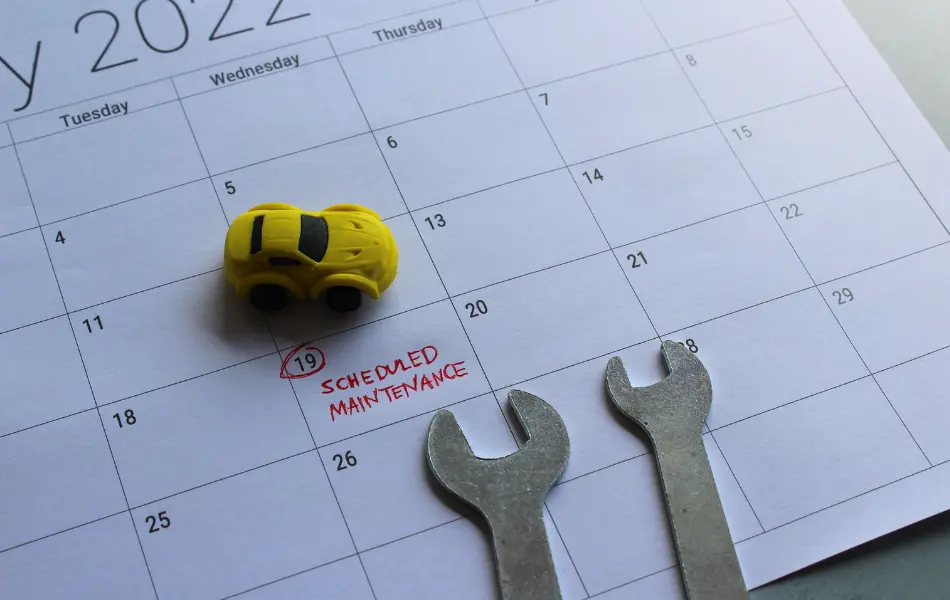
Taking proper care of your used car after purchase is essential to ensure its longevity and reliability. Start by familiarizing yourself with the car's maintenance schedule, which can typically be found in the owner's manual. Regular maintenance tasks include oil changes, tire rotations, brake inspections, and fluid checks. Staying on top of these routine services helps prevent major issues and keeps your car running smoothly.
It's also important to establish a relationship with a trusted mechanic who can provide reliable and honest service. Regularly scheduled maintenance appointments allow your mechanic to identify and address potential problems before they become serious. Additionally, keeping detailed records of all maintenance and repairs can be valuable if you decide to sell the car in the future. Having a comprehensive service history demonstrates that the car has been well-maintained, which can enhance its resale value. If you're browsing online, check out used cars for sale in Elkridge, MD for trusted local options.
Beyond routine maintenance, taking care of your car's exterior and interior is also important. Regularly washing and waxing the exterior helps protect the paint and prevent rust. Keeping the interior clean and free of clutter not only makes for a more pleasant driving experience but also helps preserve the car's value. Consider using seat covers and floor mats to protect the upholstery and carpeting. By following these post-purchase tips, you can ensure that your used car remains in great condition for years to come, providing you with reliable transportation and peace of mind.


